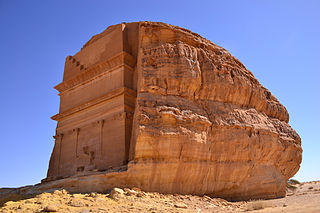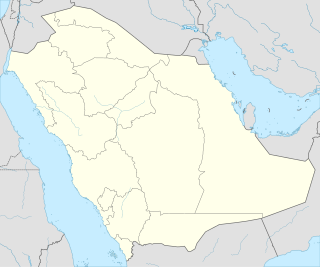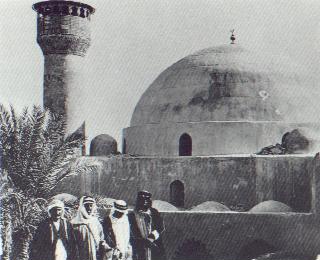 W
WAbu Loza's Bath is a historic Turkish bath in Saudi Arabia. The bath utilizes sulfur mineral water spring. It is located in the village of the Qatif Governorate.
 W
WHegra, also known as Mada’in Salih, or Al-Ḥijr (ٱلْحِجْر) is an archaeological site located in the area of AlUla within Al Madinah Region in the Hejaz, Saudi Arabia. A majority of the remains date from the Nabatean kingdom. The site constitutes the kingdom's southernmost and largest settlement after Petra, its capital. Traces of Lihyanite and Roman occupation before and after the Nabatean rule, respectively, can also be found.
 W
WThe Hejaz Railway Museum in Medina is a railway museum that was opened in 2006. It is on the grounds of the restored historic Ottoman railway station at Medina, locally called استسيون "Istasyōn", including a stretch of the historic track and a train shed with originally four tracks. There are several engines and pieces of rolling stock on display, some of which has been transported to the museum from other places along the historic Hejaz railway line. At least one engine has been restored enough to be driveable on the museum tracks. It is, along with the old train station at Mada'in Saleh, one of two museums in Saudi Arabia dedicated to the Hejaz railway.
 W
WThe King Abdulaziz Center for World Culture (Ithra) also known as Ithra, is situated in Dhahran, Saudi Arabia. It was built by Saudi Aramco and inaugurated by King Salman bin Abdulaziz on December 1, 2016. It is operated by Saudi Aramco and is currently the company’s main corporate social responsibility initiative with a focus on culture, learning and cross-cultural activities. The Center is located where the first commercial Saudi oilfield was found in March 1938. The Center incorporates a museum, children museum, library, cinema, theater, and exhibition halls. It was designed by the Norwegian architectural firm Snøhetta. The Center has been listed in Time magazine as one of the world’s top 100 places to visit and attracted one million visitors in 2019. The director of Ithra is Hussain N. Hanbazazah.
 W
WAl-Madinah Museum is a museum in Al-Madinah, Saudi Arabia, that exhibits Al-Madina heritage and history featuring different archaeological collections, visual galleries and rare images that related to Al-Medina. The museum exhibits around 2,000 rare artifacts that capture the heritage and culture of Al-Madinah and document the landscape, the people and how it has been shaped over the years. One of the most interesting parts of the tour is the evolution of Masjid Nabawi from a house, courtyard, and home to the massive complex that it is now.
 W
WNasseef House or Nassif House is a historical structure in Al-Balad, Jeddah, Saudi Arabia. As of 2009 it is a museum and cultural center which has special exhibits and lectures given by historians.
 W
WQasr Ibrahim is a historical castle and fort that is located in the north of Alqoat neighborhood, Hofuf, Al-Ahsa, Eastern Province, Saudi Arabia. Besides, it is called the dome Palace, AlQoat Palace or Ibrahim Castle. Ibrahim palace is the main architectural heritage from the Ottoman period of Al-Hofuf that was a Turkish military barracks. After that, the palace was taken and seized by King Abdul-Aziz Al Saud in April 13, 1913.
 W
WAl-Salam Museum is a museum planned to be constructed to the west of the Prophet's Mosque in Madinah, Saudi Arabia. The total area of the museum is around 17,400 square metres (187,000 sq ft). The establishment of the museum is planned to be completed within 12 months, starting from May 2019.
 W
WSūq ʿUkāẓ is a souq, or open air market, at ʿUkāẓ, between Nakhla and al-Ṭāʾif, in Saudi Arabia. It was the largest and best known souq in pre-Islamic times. Today it is a popular tourist destination.
 W
WTabuk Castle is an ancient castle in Tabuk, the capital city of the Tabuk Region in northwestern Saudi Arabia which dates back to 1559. The castle has been rehabilitated and transformed into a museum open to all visitors.
 W
WFort Tarout or Tarout Castle is a historic castle located at the top of a hill in the center of Tarout Island, Qatif, eastern Saudi Arabia. The base at which the castle was built on goes back to 5000 BC. The castle itself was built on the base of an old Phoenician temple, that was dedicated to Astarte, during Uyunid Emirate other researchers believe that it was built in the 16th century between 1515 and 1520 AD during Portuguese invasion of Persian gulf and was one of their defense point after they have restored it in 29 March 1544. Tarout castle was originally built during the rise of Dilmun civilization, dedicated to the worship of Mesopotamian goddesses, such as Ashtar, which the name Tarout is derived from. The fort dates back to 5000 years ago, which many inscriptions were found in it and so Mesopotamian God's statues. Invaded by the Portuguese in the 16th century, which they took as a military base, and later was left in ruins. It has an oval-shaped irregular inner plan that has a total area of no more 600 square metres (6,500 sq ft), surrounded by a wide wall constructed with sea mud, gypsum, and Fourosh rocks. it had a 4 towers in total one was destroyed during a battle.
 W
WThe Two Holy Mosques Architecture Exhibition is located in Um al-Joud area, near the Kiswa Factory. Since its establishment it has become one of the most popular destinations in Makkah, Saudi Arabia. It was established in February 2000 during the late King Fahd bin Abdulaziz era.
 W
WAl-Zaher Palace Museum in Makkah, Saudi Arabia, is a historical museum that exhibits the history of Makkah and various archaeological collections for different periods of Islamic history in the region and was built in an area of 2700 m2 covering two stories and surrounding gardens. It was built with an Islamic architectural style with cut and carved stone.